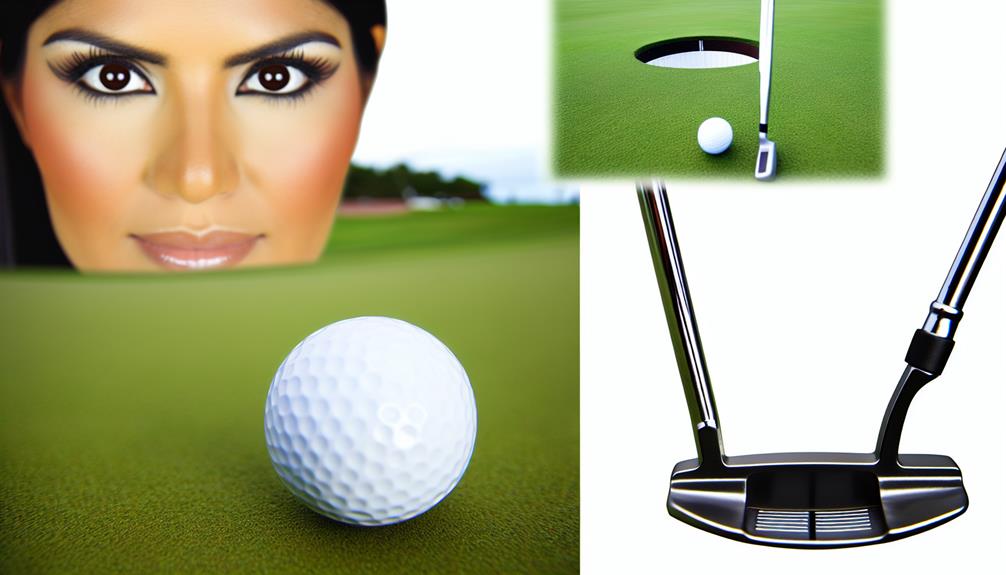Just as you're thinking about perfecting your golf putting, we're here to provide you with six essential tips to do just that.
You're probably well aware that putting can make or break your game, and it's no secret that even the pros struggle with it from time to time.
But don't worry, we've got you covered. Whether it's understanding the basics, mastering the perfect grip, or developing a consistent rhythm, we've got strategies that'll help you up your game.
Eager to know how these tips could turn your game around? Let's get started.
Understanding the Basics of Putting
Before you can truly master the art of putting in golf, you'll need to grasp the fundamental principles, such as reading greens, understanding putter designs, and perfecting your stroke.
The first step, putter selection, is crucial. Not all putters are created equal, so you'll want to choose one tailored to your style and skill level. Consider aspects like the putter's weight, length, and design. Remember, your putter should feel like an extension of your arm, not a foreign object.
Next, mental preparation is paramount. Putting is a mental game as much as it's a physical one. You need to visualize your shot, calculate the distance, and anticipate the ball's path. It's not just about how hard to hit the ball, but also about how to manage the subtle undulations of the green.
Perfecting Your Putting Grip
Having chosen your ideal putter and prepared your mind, it's essential to now focus on refining your grip, a vital aspect that directly influences the control and accuracy of your putt.
Grip variations vary from golfer to golfer, but there are a few universal guidelines that can help you perfect your putting grip.
Firstly, position your hands closer to the top of the putter handle. This hand positioning provides better control over the putter's movement. Your thumbs should point straight down the shaft, creating a 'V' shape with your forefinger and thumb of each hand.
Secondly, experiment with different grip variations. The most common are the reverse overlap, the cross-handed, and the claw grip. The reverse overlap has the index finger of your left hand overlapping the fingers of your right hand (if you're a right-handed golfer, vice versa for left-handed golfers). The cross-handed grip, also known as the left-hand low, involves placing your left hand below your right. The claw grip involves holding the putter like a pencil.
Importance of Correct Alignment
Why is correct alignment so crucial in golf putting, you may wonder? It's simple. Proper alignment can make or break your golf game. It's the key to directing your golf ball accurately towards the hole.
Imagine you've got your grip perfected, but your shot strays off course. That's where alignment steps in. By making minor adjustments, you can improve your game significantly. This is where the use of alignment tools becomes invaluable. They help you perfect your stance, aim, and direction of your swing.
Now, let's talk about eye line adjustments. If you're not viewing the ball from the correct angle, your perception can be off, leading to a misguided shot. It's essential to line your eyes parallel to your target line for an accurate shot. This can be tricky to perfect, but with regular practice, you'll get there.
Mastering Putting Speed Control
While perfecting your alignment is vital, it's equally important to master your putting speed control to ensure the ball reaches the hole with just the right amount of force. Proper speed control can prevent the ball from overshooting or stopping short, thus enhancing your chances of sinking the putt.
One of the key factors in speed control is understanding the Green Reading Techniques. These techniques allow you to assess the green's slope, grain, and the moisture level, which all influence how fast or slow the ball will roll. For uphill putts, you'll need more force; for downhill putts, you'll need less.
Next, you must be good at Evaluating Putt Distance. To do this, use your eyes and feet to gauge the distance. Look at the hole, then the ball, and visualize the path in between. Walk the line if possible. The more accurately you can judge the distance, the better you can control your putting speed.
Lastly, practice makes perfect. Experiment with different putting speeds on various types of greens. With time, you'll develop a feel for the right speed, enhancing your overall putting performance.
Developing Consistent Putting Rhythm
Beyond mastering speed control, it's essential to develop a consistent putting rhythm to enhance your golfing game. Your rhythm, the rhythm of your swing, is a significant factor in successful putting. It's all about repetition and consistency.
Start by visualizing putts. Create a mental image of the ball's path and how your swing will drive it there. This aligns your mind and body to work together, establishing a rhythm before you even touch the club.
Next, concentrate on your grip. It should be firm yet relaxed to allow a smooth swing. Your posture is crucial too. Stand comfortably with your eyes over the ball. This position promotes a natural, rhythmic swing.
Incorporate breathing techniques into your routine. This might seem unrelated to golf, but it's a proven method to enhance focus and relaxation. Take a deep breath before you swing, maintaining a steady rhythm. Exhale as you make contact with the ball.

